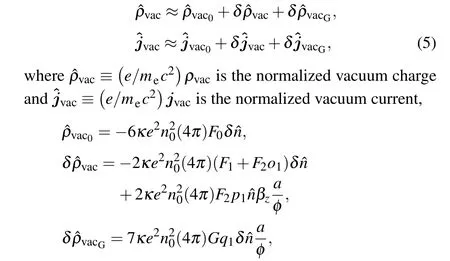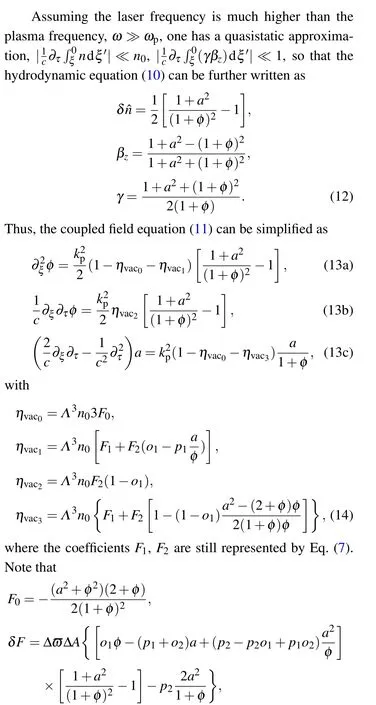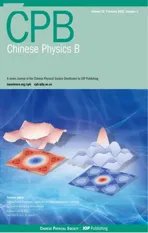Correction of intense laser-plasma interactions by QED vacuum polarization in collision of laser beams
2023-03-13WenBoChen陈文博andZhiGangBu步志刚
Wen-Bo Chen(陈文博) and Zhi-Gang Bu(步志刚)
1Department of Physics,Shanghai University,Shanghai 200444,China
2State Key Laboratory of High Field Laser Physics,Shanghai Institute of Optics and Fine Mechanics,Chinese Academy of Sciences,Shanghai 201800,China
Keywords: vacuum-polarization effects,extreme intensity laser,laser-plasma interactions
1.Introduction
The intensity of the laser source has been one of the most important issues in laser-plasma interactions.When the intensity of a focused laser reaches or exceeds 1018(1µm/λ)2W/cm2,the perturbation method becomes inapplicable and nonlinear theory of laser-plasma interactions is necessary.[1]Further, when the intensity of the laser exceeds 1023(1 µm/λ)2W/cm2, plasmas in the interactions are ultra-relativistic and the physics of relativistic plasmas are strongly affected by strong-field quantum electrodynamic(QED)processes.[2]This coupling of quantum processes and relativistic collective particle dynamics can result in significantly new physics phenomena.[3,4]In this situation, the behavior of lasers with extreme intensity also becomes notably different from that of lasers with lower intensity in plasma.In particular,vacuum polarization effects cause the laser to propagate in a vacuum as if it is in nonlinear media.Thus,vacuum polarization effects must be considered when studying the relevant interaction processes.
A large number of laser-plasma interaction processes,such as inertial confinement fusion(ICF),star surface plasma layer, etc., usually are multi-light processes.An ideal single laser source propagating in plasma is almost non-existent.This makes it necessary to study the QED vacuum polarization effects induced by multiple lasers and their laser-plasma interaction processes.When there are multiple extreme intensity lasers propagating through the vacuum, the multiphoton processes of strong-field QED such as photon-photon scattering effects become important.[5-7]Most of the QED vacuum polarization effects can be attributed to the results of these processes.[8]We know there is no direct interaction between light and light propagating in a vacuum in classical electrodynamics.However,in the overlapping area of two light beams,interference appears due to the wave character of light; once they leave the overlapping area, the two light beams are no longer affected by each other and their propagation properties are unchanged.The two beams of light do not scatter in the overlapping region, and no energy or momentum are exchanged.However,the existence of QED vacuum polarization effects changes this classical description.In quantum theory,the multiphoton processes are a nonlinear interaction with the electron-positron pairs of vacuum fluctuations acting as an intermediate“media”.In contrast with the well-known Faraday or Cotton-Mouton effect, which is essentially the (circular)birefringence phenomenon of light under different polarization states in a material, induced by the projection of a magnetic field along or perpendicular the propagation direction of the light and caused by the motion of the charged particles in this material under the Lorentz forces of the external magnetic field,the process of QED vacuum polarization is a photon transferring a portion of its energy and momentum to another by interacting with a virtual particle pair in the quantum vacuum, causing scattering effects.[9]This effect of extreme intensity light does not necessarily require an additional field and is typically nonlinear and dissipative.Research on multiphoton processes in strong-field QED has led to some progress in theory and experiments.[10-14]In current experimental conditions, the observation of these QED processes has not yet been implemented directly.[15]However,with the completion of infrastructures such as Extreme Light Infrastructure(ELI),Appollon and Shanghai Superintense Ultrafast Laser Facility(SULF),it is believed that there will be a breakthrough in the near future.
On the other hand,special media such as plasmas can effectively enhance QED vacuum polarization effects.When strong intensity lasers are injected into the plasma, plasma fields due to the interactions between the lasers and collective effects of electrons in plasma are generated.If the intensity of the incident laser is ultra-high and the number density of the plasma is large enough,the coupling effect of vacuum polarization and plasma fields becomes unable to be neglected.Considering the effects of vacuum polarization in an ultra-intense laser and plasma interaction is necessary.Such research includes Lundinet al.who studied the plasma dispersion relation,[16,17]Bu and Ji who studied the correction of the laser pulse frequency shift,[18]and our previous paper which investigated the correction of the nonlinear interaction.[19]These works show that plasmas are useful for studying QED vacuum polarization effects.Specific to the work related to multiple extreme intensity laser QED vacuum effects in plasmas, there are also Roberts’s research on x-ray free electron laser,[20]Shenet al.’s study of vacuum birefringence,[21]and Kogaet al.’s work on the use of relativistic flying mirrors to study photon-photon scattering effect observability,[22]etc.
In this paper,the laser field dynamics equation including the QED vacuum polarization in collision of laser beams is discussed in detail.Combined with the hydrodynamic equation of a plasma,nonlinear coupled equations with QED vacuum correction are obtained.The corrections of vacuum polarization from colliding lasers has a larger correction magnitude and is more varied than that from the single laser source condition.It also causes the laser propagation direction and the polarization direction to produce components that are different from the original direction.In laser-plasma interactions,the collision process not only changes the properties of the laser’s direction of propagation, polarization, etc.after the overlapping region,but also causes a corresponding change in the laser-driven plasma wave(the laser wakefield).Detecting various changes of lasers in the plasma and the plasma waves may provide a good solution for observing the vacuum polarization effects in experiments.
2.Laser field equations with QED vacuum polarization in collision of laser beams
The nonlinear effects of a QED vacuum can be described by the Heisenberg-Euler(HE)Lagrangian density.Thus, the Lagrangian density of electromagnetic fields with nonlinear QED vacuum polarization effects can be written as[23]

whereδn=n-n0is the density perturbation of electrons,n0is the ambient plasma density, andvis the electron fluid velocity.In our model, the ions are considered as stationary, so the effect of the mass and charge of the ions is not accounted for.Equation (3) demonstrates the vacuum polarization effects with effective vacuum“sources”, vacuum“charge”ρvacand vacuum“current”jvac,
The electromagnetic field takes the Coulomb gauge ∇·A=0,whereAis the vector electromagnetic potential.Considering that the electromagnetic field is composed of two lasers, we obtain the relations ∇=ez1∂z1+∇⊥1+ez2∂z2+∇⊥2;A=Az1+A⊥1+Az2+A⊥2and Φ=Φ1+Φ2, where Φ is the scalar electromagnetic potential, laser 1 propagates along thez1axis direction and laser 2 along thez2axis direction.In the case of neglecting the effects of self-focusing and diffraction of each laser beam, the propagation of these two lasers can be described in a paraxial monochromatic model, ∇→ez1∂z1+ez2∂z2=ez1∂/∂z1+ez2∂/∂z2.Considering intense lasers with large amplitude,the transverse component of vector potentials,perpendicular to thez1axis andz2axis direction respectively, is much larger than its longitudinal component,|Az1|≪|A⊥1|, A1≈A⊥1=Ae⊥1;|Az2|≪|A⊥2|, A2≈A⊥2=Ae⊥2.
In our electromagnetic field model, the initial electromagnetic potentials of laser beams can be described asAl(zl,t)=Al0(zl,t)eiΨlandΦl(zl,t)=Φl0(zl,t)eiΨl, whereAl0(Al0,Φl0) andΨl=-ωlt+klzl+ψlare the amplitude and phase of the electromagnetic potential of the two lasers(l=1,2).During the process of the laser beams propagating in media, the beams’amplitude and phase will be perturbed.In the calculation of vacuum“sources”ρvacandjvacfrom Eq.(4),only the perturbations of their amplitudeδAl(δAl,δΦl)and phaseδψlinduced by the vacuum polarization effects need to be considered, and they are small-varying, i.e.,|δAl|≪|Al0|,|δψl|≪|ψl|, (l=1,2).The electromagnetic potentials in Eq.(4)can be written asAl[Al(zl,t),Φl(zl,t)]=[Al0+δAl(zl,t)]ei[Ψl(zl,t)+δψl(zl,t)].Therefore, in the process of calculating the corrections of the vacuum polarization effects in Eq.(4),∂iAl= i∂i(-ωlt+klzl)Al+O(zl,t),
whereO(zl,t) = i∂i(δψl)Al+∂i(δAl)ei(Ψl+δψl) is the higher-order derivative.Only the first-order derivative is needed to obtain approximate relations (∂iAl)(∂jAl)≈(∂i∂jAl)Al,(∂iΦl)(∂jΦl)≈(∂i∂jΦl)Φl,(∂iAl)(∂jΦl)≈(∂i∂jAl)Φl ≈(∂i∂jΦl)Al ≈(∂iΦl)(∂jAl), wherei,j=t,zl, l= 1,2; and∂i1A1/∂i2A2~ΔϖΔA,∂2i1A1/∂2i2A2~Δϖ2ΔA, ∂i1Φ1/∂i2Φ2~ΔϖΔA, ∂2i1Φ1/∂2i2Φ2~ Δϖ2ΔA,where Δϖ ≈ω1/ω2,ΔA ≈A10/A20, i=t,z.For laser 1,the base vector representing the direction of its wave vector can be written asez1=o1ez2+p1e⊥2+q1ez2×e⊥2,and the base vector representing the direction of its vector potential can also be written ase⊥1=o2ez2+p2e⊥2+q2ez2×e⊥2,o2i+p2i+q2i= 1, oioj+pipj+qiqj= 0, i,j= 1,2.The relationso1=ez1·ez2, p1=ez1·e⊥2, o2=e⊥1·ez2, p2=e⊥1·e⊥2are the angle cosines between wave vectors and the vector potential of the two lasers.It is assumed that the frequency of laser 1 is much higher than that of laser 2 to obey the following relations,Δϖ ≫1,ΔϖΔA ≫1,so that the effects of laser 2 on laser 1 can be neglected.Therefore,we only need to calculate the wave equation of laser 2 during the propagation process.In the following calculation,the lower corner“2”can be omitted,A2~A, Φ2~Φ, z2~z, ⊥2~⊥, n2~n.Considering that the HE coupling coefficientκis very small(κabout 10-32cm·s2·g-1), in the case of the laser field being much smaller than the critical fieldEcr, the correction of vacuum polarization expressed in the form of vacuum “sources” can be written as the perturbation in terms ofκ,and the high-order terms ofκcan be omitted.The vacuum “sources” of laser 2 from Eq.(4)can be expanded into


whereφ ≡(e/mec2)Φanda ≡(e/mec2)Aare the normalized scalar and vector electromagnetic potentials,δˆn=δn/n0,ˆn=n/n0, β⊥=v⊥/c, βz=vz/c.New components of the wave vectorδkG, along the direction ofq1e⊥-p1ez×e⊥, and new components of vector potentialδAG, alongq1ez+(1-o1)ez×e⊥,produced by one of the vacuum“sources”δˆρvacGandδ^jvacGare in a different direction from their originalk,along thezaxis, andA, along the⊥axis.If we only focus on the variations of field equations along the originalkandAdirection of laser 2,we can neglect the influence ofδˆρvacGandδ^jvacG,i.e.,assumeG →0,δˆρvacG≈0 andδ^jvacG≈0.Ignoring the new componentsδkGandδAGin the wave equations,Eq.(3)can approximate the wave equations with the vacuum polarization effects describing laser 2.Its expressions are

3.Response of multi-light vacuum polarization in nonlinear intense laser field-plasma interactions
A new nonlinear coupling model of colliding extreme intensity lasers is given via combining the intense laser-plasma interaction theory with the wave equations including the quantum vacuum effects.The plasma wave(laser wakefield)generated by the laser in the plasma is described by the multicomponent fluid plasma model.The hydrodynamic equations consist of a continuity equation and a momentum equation,


Λ3=(8/45)α2λ3C≈5.45×10-37cm3is the coupling coefficient of vacuum polarization.In Eq.(14),ηvac0,ηvac1,ηvac2,andηvac3are the correction rates of QED vacuum polarization effects.If there is no contribution of vacuum polarization effects, i.e.,F0~F1~F2→0, andηvac0~ηvac1~ηvac2~ηvac3~0,Eq.(13)are reduced to the classical nonlinear equations.If there is only a single laser source,i.e.,F1~F2→0,andηvac1~ηvac2~ηvac3~0,equation(13)is reduced to the form without collision corrections which is given in Ref.[19].
4.Discussion and conclusion
In this paper, a new nonlinear paraxial monochromatic coupling model is given,which can deal with the contribution of multi-light vacuum polarization effects in a intense laserplasma interaction.This model allows us to study the physical conditions of multi-beam ultra-intense laser propagation in a laser-plasma environment.
The HE correction rate,ηvac0=Λ3n03F0, corresponds to the modification of the coupled field caused by the vacuum “sources” ˆρvac0and ^jvac0in Eq.(5), which are generated from the extremely high intensity of the laser itself.Assuming the nonlinear condition, i.e., the amplitude of the normalized vector potentiala20≫1, thenF0inηvac0is about|F0|max~a20.It is easy to obtain the relation betweena0, the laser intensityIand the laser wavelengthλasn0a20~7.3×10-11n0[λ(cm)]2I(W/cm2)=7.3×10-11·π(mc2/e2)(ωp/ω)2I(W/cm2)=816(ωp/ω)2I(W/cm2).[24]In the case thatωp/ω~0.1, the incident laser intensity reachesI~1025W/cm2, and plasma number densityn0~1024cm-3, thena0~10, and the correction parameterηvac0max=Λ3n0a20can reach 10-11.
The collision correction rates,ηvac1,ηvac2,andηvac3,correspond to the influence of the QED vacuum polarization effects of the two colliding lasers in the laser-plasma interaction system,due to the modifications of the coupled field caused by the vacuum “sources”δˆρvacandδ^jvacin Eq.(5), which add their value if the lasers collide in the quantum vacuum.These correction rates,ηvac1,ηvac2,andηvac3,consist ofF1,F2.Under the nonlinear condition(a0≫1),from Eq.(7),the relation between these two coefficients isF2~ΔϖF1.F1,F2is composed ofF0,δF,whereδFdepends on the angle between the two laser propagation directions.



Fig.1.Magnitudes of collision correction rates (a) ηvac1max, (b) ηvac2max, and (c) ηvac3max versus angle cosines of the two lasers o1, o2 for p1 >0, q1 =0,Δϖ ~10,ΔA ~1,I=1025 W/cm2,n0=1024 cm-3 and ωp/ω =0.1.
According to the above discussions, we found that compared withηvac0,the collision correction ratesηvac1,ηvac2andηvac3are significantly larger in magnitude.Especially noteworthy is the existence ofηvac2and Eq.(13b); new effects of the quantum vacuum appear in the coupled field along the direction of the laser and its wakefield propagation.These do not exist in the classical equations or the one only considering the quantum vacuum effect of a single laser beam.Moreover, figure 1 shows that by changing the incident angle and the polarization direction of the two lasers,the corresponding magnitude of the collision correction rates also changes.It is possible to effectively enhance the magnitude ofηvac1,ηvac2,andηvac3in the laser-plasma interaction system by increasing the intensity of the incident lasers or the frequency difference between the two lasers, or the number density of the plasma.The results indicate that as well as a higher intensity of lasers,a higher number density of free electrons and ions in a plasma also helps the virtual particle pairs by quantum fluctuations to transfer energy and momentum between multiple colliding intense lasers.For example, for the electron number density of plasman0,in future ICF experiments,n0~1025cm-3,and in the regime of astrophysics,n0~1030cm-3in compact objects such as dwarfs.In these multi-light physical environments,the effect of vacuum polarization is quite significant.These are all shown in Figs.2-4.

Fig.2.Magnitudes of vacuum polarization effect correction rates ηvac0max, ηvac1max, ηvac2max, and ηvac3max in different laser intensity I for o1 =o2 = p2 =0, p1 =1,Δϖ ~10,ΔA ~1,n0 =1024 cm-3 and ωp/ω =0.1.

Fig.3.Magnitudes of vacuum polarization effect correction rates ηvac0max, ηvac1max, ηvac2max, and ηvac3max in different plasma density n0 for o1 = o2 = p2 = 0, p1 = 1, Δϖ ~10, ΔA ~1, a0 ~10 and I=1025 W/cm2.

Fig.4.Magnitudes of vacuum polarization effect correction rates ηvac0max, ηvac1max, ηvac2max, and ηvac3max versus frequency ratios of the two laser Δϖ for o1=o2= p2=0, p1=1,ΔA ~1,I=1025 W/cm2,n0=1024 cm-3 and ωp/ω =0.1.
On the other hand, due to the multi-light vacuum polarization effects, some scattered photons are generated with different directions from the lasers’ original propagation direction and polarization direction.Some of them induce the vacuum “sources”δˆρvacGandδ^jvacGto modify the coupled field.ComparingδˆρvacGandδ^jvacGwith other kinds of vacuum “sources”δˆρvacandδ^jvacin Eq.(6), and comparing the corresponding coefficientGwithF0andδFin Eq.(8),we can estimate the approximate magnitude range of the correction rateηvacGcaused byδˆρvacGandδ^jvacGis aboutΛ3n0a40ΔϖΔA<ηvacG<Λ3n0a50ΔϖΔA.Assuming the same parameters as before, Δϖ~10, ΔA~1,a0~10, we obtain 10-7<ηvacG<10-6.The existence of these kinds of scattered photons also causes the wave vectorkof the laser to produce a component along the direction ofq1e⊥-p1ez×e⊥,different from its original propagation direction along thezaxis,and the vector potentialAof the laser to produce a component along the direction ofq1ez+(1-o1)ez×e⊥, different from its original polarization direction along the⊥axis.Further detailed analysis of this kind of correction requires threedimensional nonlinear laser-plasma interaction theory.The propagation of the scattered photons in the plasma can further cause secondary effects.These may also be observed in stateof-the-art experiments of QED quantum vacuum polarization effects.
Acknowledgments
The authors would like to thank Prof.Xianhui Ge for helpful discussions.Project supported by the National Natural Science Foundation of China (Grant No.11805117) and the Shanghai Leading Academic Discipline Project (Grant No.S30105).
杂志排行
Chinese Physics B的其它文章
- Matrix integrable fifth-order mKdV equations and their soliton solutions
- Comparison of differential evolution,particle swarm optimization,quantum-behaved particle swarm optimization,and quantum evolutionary algorithm for preparation of quantum states
- Explicit K-symplectic methods for nonseparable non-canonical Hamiltonian systems
- Molecular dynamics study of interactions between edge dislocation and irradiation-induced defects in Fe-10Ni-20Cr alloy
- Engineering topological state transfer in four-period Su-Schrieffer-Heeger chain
- Spontaneous emission of a moving atom in a waveguide of rectangular cross section
